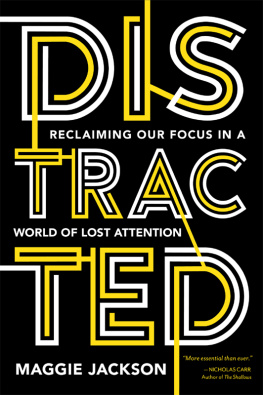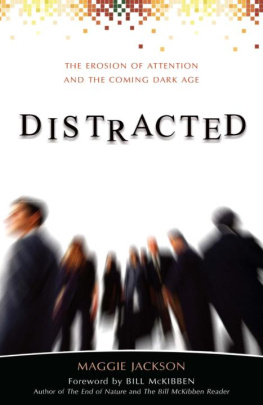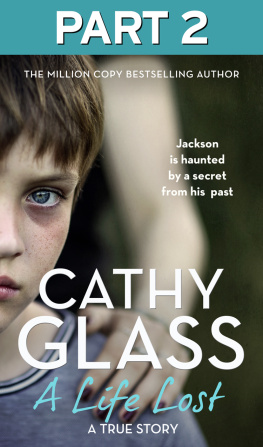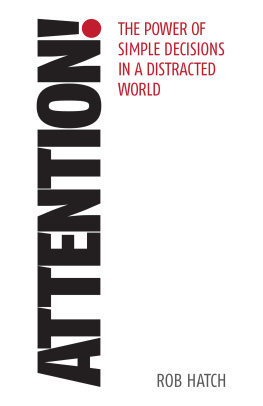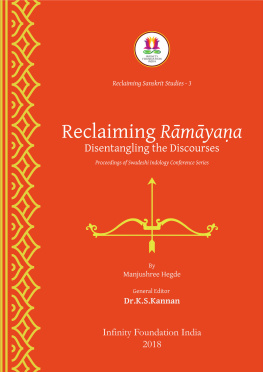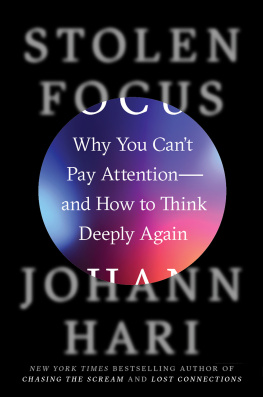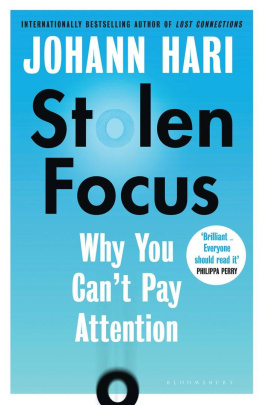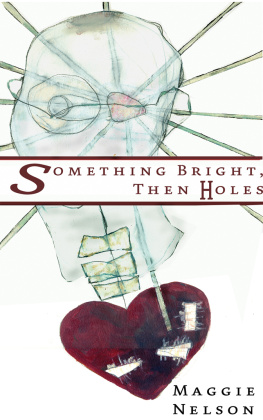Maggie Jackson - Distracted : Reclaiming Our Focus in a World of Lost Attention
Here you can read online Maggie Jackson - Distracted : Reclaiming Our Focus in a World of Lost Attention full text of the book (entire story) in english for free. Download pdf and epub, get meaning, cover and reviews about this ebook. year: 2018, publisher: Prometheus Books, genre: Home and family. Description of the work, (preface) as well as reviews are available. Best literature library LitArk.com created for fans of good reading and offers a wide selection of genres:
Romance novel
Science fiction
Adventure
Detective
Science
History
Home and family
Prose
Art
Politics
Computer
Non-fiction
Religion
Business
Children
Humor
Choose a favorite category and find really read worthwhile books. Enjoy immersion in the world of imagination, feel the emotions of the characters or learn something new for yourself, make an fascinating discovery.
- Book:Distracted : Reclaiming Our Focus in a World of Lost Attention
- Author:
- Publisher:Prometheus Books
- Genre:
- Year:2018
- Rating:3 / 5
- Favourites:Add to favourites
- Your mark:
- 60
- 1
- 2
- 3
- 4
- 5
Distracted : Reclaiming Our Focus in a World of Lost Attention: summary, description and annotation
We offer to read an annotation, description, summary or preface (depends on what the author of the book "Distracted : Reclaiming Our Focus in a World of Lost Attention" wrote himself). If you haven't found the necessary information about the book — write in the comments, we will try to find it.
Distracted : Reclaiming Our Focus in a World of Lost Attention — read online for free the complete book (whole text) full work
Below is the text of the book, divided by pages. System saving the place of the last page read, allows you to conveniently read the book "Distracted : Reclaiming Our Focus in a World of Lost Attention" online for free, without having to search again every time where you left off. Put a bookmark, and you can go to the page where you finished reading at any time.
Font size:
Interval:
Bookmark:

In writing this book, I asked many people for the gift of their attention. I am deeply grateful to all those who generously shared their time, stories, wisdom, and thoughts with me.
My most wise and patient teacher has been Mike Posner, who patiently endured hundreds of questions in my years-long quest to understand the science of attention. I also benefited greatly from the insights of Naomi Baron, Philip David Zelazo, Stephanie Carlson, Dave Meyer, Bruce McCandliss, Norbert Elliot, Alan Wallace, Elinor Ochs, Amishi Jha, Carol Kuhlthau, James McGaugh, George Kuh, Dan Anderson, Brian Wansink, Art Kramer, Kevin Guise, Frances Kuo, Bill Gehring, David Fencsik, Mike Liebhold, Jim Mulvaney, Abby Smith, and Rebecca Baron.
Others graciously supported this work in myriad ways. Many thanks to Emma Sweeney and her team; the wonderful staff of the New York Society Library; and especially Carolyn Waters; Steve McGuirl; and Sara Elliott Holliday; the New York Public Library's main research division; and Stuart Basefsky, a senior reference librarian at Cornell University. A number of people commented on the manuscript, in part or in full: Wallis Miller, Karen Cornelius, Norbert Elliot, Peter Cavaluzzi, Jim Burns, Allison Cheston, John Fossella, and Ozlem Ayduk. (All errors are, of course, my own.) I also appreciated the encouragement of Sherry Turkle, Nicholas Carr, Alan Lightman, A. J. Jacobs, Alexandra Horowitz, Gretchen Rubin, Doug Peterson, Maureen Ahn, Per and Gabriella Augustsson, Lynn Novick, Leslie Brody, Spencer Smul, Karen Smul, John Bessler, Ellen Feldman, Alexandra Kahn, Andrea Saveri, Ross Barrett, Roger Winter, Ellen Galinsky, Carol Guensburg, Arlene Johnson, Amy Klobuchar, Sarah Marvin, Michael Hagner, Sharon Posner, Rosemary Bowen, Jim and Ann Marie Hitchcock and the Hitchcock clan, Pam Bailey, Tom Joyce, Kate Bailey, Clista Dow, Merrill Smith, Lisa Jackson, Mark Gallogly, Lisa Brainerd, Cindy Wentworth, and Lise Strickler.
I am grateful to Jonathan Kurtz, Steven L. Mitchell, the late Linda Regan, Jill Maxick, Jake Bonar, and so many others at Prometheus Books. I am deeply appreciative of the ongoing wisdom and vision of Richard Pine and Eliza Rothstein.
Time and again, the fascinating subject of attention captured my attention fully, yet my family cheered me on and soldiered on, with understanding and patience. John, Emma, and Anna shared the ups and down of the research and writing, endured my absences and worries, did more than their share of the chores, and still met me at the door with hugs and welcome home signs. Thank you.
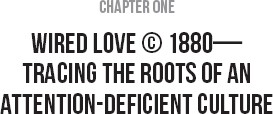
I hope sometime we may clasp hands bodily as we do now spiritually, on the wirefor we do, don't we, said C.
Certainly, here is mine spiritually! responded Nattie without the least hesitation, as she thought of the miles of safe distance between.
Wired Love: A Romance of Dots and Dashes
The quaint words date this prose. This fictional scene is set in an era of horse-drawn carriages, hoop skirts, and chaperoned outings. Two young telegraph operators begin quarreling, then chatting, over the wire and eventually fall in love after a long flirtatious exchange of messages and innuendo, all heard by other operators up and down the same telegraph line. When they finally meet, they are so tongue-tied and distracted by jealousies and other real-world complications that they only get engaged after setting up a private telegraph line between rooms in a boardinghouse so they can tap out their amorous feelings. Their story unfolds in Wired Love: A Romance of Dots and Dashes, an 1880 novel that ends with a Morse code proposal from C to N.
Wired Love is a long-forgotten literary footnote, a peek into a time far removed from the whirling, speeding Technology Plays, when dusty rail journeys and stereopticon slide-viewers were considered state of the art. But this minor portrait is worth resurrecting if we are to understand how we arrived at an age of splintered attention. For although we breezily assume that smartphones, Snapchat, and text messages inspired our split-screen, split-second life, we must remember that virtual love didn't start with the Internet, and jets and cars didn't entirely make us the nomads we are today. The era captured in Wired Love signaled a panoply of heady, new powers for humankind that seemed to break our earthly fetters, shift our worldand set off changes that ushered us toward a land of distraction.
Simultaneity, or the seeming ability to exist in two places at once, rewrote the nature of human communication and set the stage for our fevered attempts to juggle multiple, mediated domains. Spiritualism, with its earnest efforts to tap into new frontiers of communication, foreshadowed our notions of cyberspace as a realm of scientific, spiritual, and social exploration. Last, the era's earnest experimentation with mediated experience and the control of perception has helped inure us to a world of fragmented, diffused, and manipulated attention. To understand our age, we must first look back. The world is stretched & folds out & squeezes shut like an accordion tortured by some sadistic hand, wrote Blaise Cendrars, an early twentieth-century French poet who tried to capture the revolutionary changes of his day. Through the rents in the sky the locomotives hurl themselves in fury. I'm afraid I've no idea how to see it through to the end.
To appreciate the emotional impact of the telegraph and then the telephone, remember that for at least one thousand years before such devices were invented, a message could be transmitted at most just one hundred miles by horseman in a day, notes Tom Standage in his history of the telegraph, The Victorian Internet. Simultaneous communication over a distance could not be imagined.
Nothing in the natural world anticipated such communications, note James Katz and Mark Aakhus in Perpetual Contact, an exploration of the impact of the cell phone. Even the all-powerful mythic Greek gods had to rely on messengers, they write.
The effect of such innovations on people's sense of time and space was electrifying, as evidenced by the fin de sicle and early twentieth-century love affair with simultaneity of all kinds. This was a time of stunning, discomfiting advances not just in communications but in travel and entertainment. The railroad, steamship, telephone, and other homeless technologies made it seem possible to be everywhere at once, noted German cultural historian Karl Lamprecht in 1912.
Little more than a decade before the publication of Ulysses, Cendrars published an intriguing and prescient little work that plays with a marriage of simultaneity in both idea and form. Claimed by the poet to be the first simultaneous book, the 1913 La Prose du Transsibrien et de la petite Jehanne de France depicts his 1904 journey from Moscow to Harbin, spiced with musings on his mistress. Illustrated with geometric splashes of color down one side and with a map of the journey across the top, the poem was printed on a six-foot-long sheet of paper that was intended to be unfolded and seen all at once. Although thoroughly low-tech by our standards, the piece nevertheless still gives readers a real sense of speed, movement, and the collapse of distance. At that time, most books rarely experimented with chronology and invariably were illustrated with stodgy picture plates distinct from the text. But Sonia Delaunay's illustrations swirl alongside the poem, with swatches of rose, mint, midnight blue, and tangerine blending into one another, seemingly impossible to confine. The poem is sparsely punctuated, and nearly every word sports a different hue or font size. A reader is pushed and pulled from ancient to modern times and places, and back again.
Next pageFont size:
Interval:
Bookmark:
Similar books «Distracted : Reclaiming Our Focus in a World of Lost Attention»
Look at similar books to Distracted : Reclaiming Our Focus in a World of Lost Attention. We have selected literature similar in name and meaning in the hope of providing readers with more options to find new, interesting, not yet read works.
Discussion, reviews of the book Distracted : Reclaiming Our Focus in a World of Lost Attention and just readers' own opinions. Leave your comments, write what you think about the work, its meaning or the main characters. Specify what exactly you liked and what you didn't like, and why you think so.

